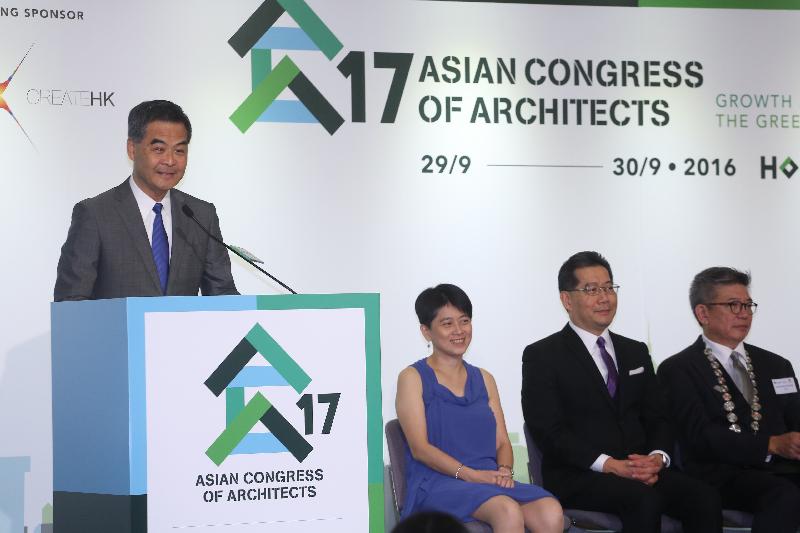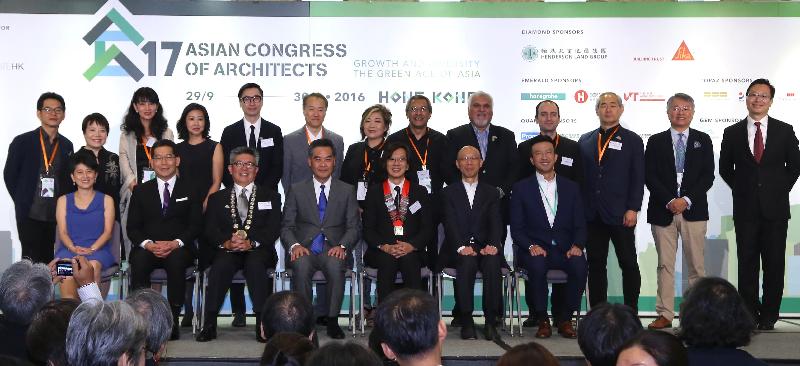Speech by CE at 17th Asian Congress of Architects (English only) (with photos/video)
************************************************************************************
Vincent (President of the Hong Kong Institute of Architects, Mr Vincent Ng), President Sathirut (President of the Architects Regional Council Asia, Mr Sathirut Nui Tandanand), Bryant (Chairman of the Organising Committee of the 17th Asian Congress of Architects, Mr Bryant Lu), government colleagues, distinguished guests, ladies and gentlemen,
Good morning. I am very pleased to welcome the prestigious Asian Congress of Architects to Hong Kong - one of the cities with the most skyscrapers - for the very first time.
If Hong Kong is known for our shortage of land, then we must be equally known for our efforts in making the best use of every single inch of it. Yes, our built environment is frequently challenged by hills, mountains and sea. But the drive, the vision and creativity of our architectural and design sector are boundless. As I know the Hong Kong Institute of Architects, your good host, will be delighted to show you.
For the next few minutes, allow me to tell you where we are, and where we plan to go, with our built environment.
The Government is committed to shaping a sustainable community, to ensuring that our future generations live, work and flourish in a city blessed with growth and diversity - a city that actively partakes in this emerging green age of Asia.
A few numbers make a telling statement about Hong Kong and the challenges we face. Our total area takes in only about 1 100 square kilometres. About 40 per cent of that land is committed to conservation and recreation, protected within 24 country parks and 22 special areas. Our green reserve co-exists with built areas - space for Hong Kong's 7.3 million people, their homes and businesses, their schools, hospitals, sports, recreation and other facilities.
More than breathtaking views, the co-existence of residential towers with mountains, development and nature, culminates to the unique charm of our city.
To preserve this delicate balance, we are determined to develop Hong Kong into a healthy, low-carbon, resource-efficient metropolis.
We have been striving towards that goal. Four years ago I started by recruiting an architect who was known for his passion for green buildings to join my government, well, not as Secretary for Development, but interestingly as Secretary for the Environment. And he is K S Wong. I suppose it says something about Hong Kong, something about the Hong Kong Government. We have a green architect in charge of the environment; we have a lawyer in charge of commerce and economy; and we have an accountant in charge of development.
Last year, we launched a new Energy Saving Plan for Hong Kong's Built Environment 2015~2025+. It sets a new target - a 40 per cent reduction in Hong Kong's energy intensity by 2025.
Buildings account for some 90 per cent of Hong Kong's electricity consumption and 60 per cent of our greenhouse gas emissions. Raising their environmental performance will have a powerful impact on the sustainability of our built environment. To lead the way, we have pledged that government buildings will reduce their electricity consumption by 5 per cent over the next four years. We are also promoting green building in about 8 000 government structures.
More than 30 government buildings have now registered under BEAM Plus. BEAM - the Building Environmental Assessment Method - is a voluntary private-sector initiative conceived in the 1990s. It is Hong Kong's rating tool for green buildings. BEAM Plus, the latest version, was launched in 2010.
The Trade and Industry Tower, commissioned last year, is a showcase of the Government's efforts in green building. We have applied a series of renewable energy technologies, including a photovoltaic system, a solar hot water system, a solar chimney and sun tubes. The project makes use of rainwater for landscape irrigation, and adopts an automatic refuse-collection system as well as low-emitting materials. That, and more, have helped the project gain a Platinum rating in BEAM Plus' Provisional Assessment.
As for new private developments, the Hong Kong Government has implemented a package of green building measures over the past five years. These include granting gross floor area concessions for green and amenity features to enhance our city's living environment.
To gain such concessions, new buildings must incorporate sustainable design elements for building separation, permeability or setback, along with the provision of greenery features and environmental and energy consumption information.
We are now developing Community Green Stations for each of our 18 districts. Operated by non-profit-making organisations, the stations will enhance environmental education and help collect recyclables, especially those of low economic value. With multi-purpose rooms and other facilities, the stations also host exhibitions, seminars, workshops and other educational activities.
Two of the stations are now up and running. Sustainable and green-building elements were adopted at the design and construction stages, such as introducing greening on-site, using container modules and a variety of green construction materials.
On the broader district level, we have been taking some bold steps in promoting energy-efficiency. A District Cooling System, for example, has been incorporated into our Kai Tak development to reduce power consumption. A huge project, Kai Tak development spans about 320 hectares, covering Hong Kong's former international airport and adjacent areas.
The District Cooling System - a centralised air-conditioning system - uses sea water to produce chilled water centrally, distributing it to consumer buildings in the Kai Tak development area through underground pipes. The system consumes 35 per cent less electricity than traditional air-cooled, air-conditioning systems, and 20 per cent less electricity than individual water-cooled, air-conditioning systems using cooling towers. The Trade and Industry Tower I mentioned earlier would be connected to this new system.
For long-term planning, we are now updating Hong Kong's overall development strategy. Our goal is to make Hong Kong a smart, green and sustainable city by integrating green spaces as part of the planning process.
Next year in June, Hong Kong will host the World Sustainable Built Environment Conference. One of the largest events of its kind in the world, the conference will attract about 1 800 green building advocates, policymakers and academics.
This will be a seminal opportunity to showcase Hong Kong's emerging green environment, while learning from green building experts and practitioners around the world. I look forward to seeing you there.
For now, ladies and gentlemen, enjoy the Congress over the next two days - as you will hear from internationally renowned architects on how we can shape a greener environment, a better world, for us all.
I wish you a rewarding Congress and a memorable stay in Hong Kong.
Thank you.
Ends/Thursday, September 29, 2016
Issued at HKT 11:06
Issued at HKT 11:06
NNNN




